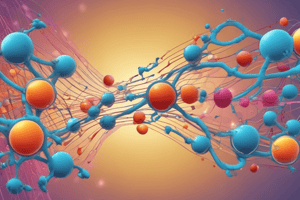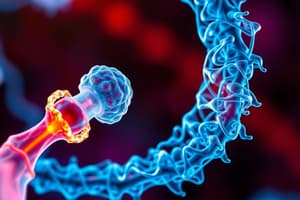Podcast
Questions and Answers
What is the primary requirement for ATP generation through the aerobic pathway?
What is the primary requirement for ATP generation through the aerobic pathway?
- Oxygen (correct)
- Carbon dioxide
- Lactic acid
- Glucose
Which of the following cells relies exclusively on aerobic respiration for ATP generation?
Which of the following cells relies exclusively on aerobic respiration for ATP generation?
- Adipocytes
- Smooth muscle cells
- Hepatocytes
- Myocardium cells (correct)
Which condition leads to the accumulation of lactic acid within cells?
Which condition leads to the accumulation of lactic acid within cells?
- Excess oxygen supply
- Increased ATP production
- High glucose levels
- Low oxygen supply (correct)
What is the consequence of damaged ATP-dependent sodium pumps on cellular function?
What is the consequence of damaged ATP-dependent sodium pumps on cellular function?
Under conditions of interrupted blood supply, which process compensates for ATP depletion?
Under conditions of interrupted blood supply, which process compensates for ATP depletion?
What is one of the signs of decreased intracellular pH due to low oxygen supply?
What is one of the signs of decreased intracellular pH due to low oxygen supply?
Which of the following correctly describes a consequence of defective oxygen supply to tissues?
Which of the following correctly describes a consequence of defective oxygen supply to tissues?
What is primarily affected when aerobic respiration fails due to low oxygen levels?
What is primarily affected when aerobic respiration fails due to low oxygen levels?
What is the role of activated caspases in the apoptosis process?
What is the role of activated caspases in the apoptosis process?
Which protein is associated with signaling in the TNF receptor pathway?
Which protein is associated with signaling in the TNF receptor pathway?
What is the outcome of nuclear damage during the apoptosis process?
What is the outcome of nuclear damage during the apoptosis process?
Which receptors are involved in initiating the apoptotic signaling cascade?
Which receptors are involved in initiating the apoptotic signaling cascade?
What molecule is recognized by phagocytes to facilitate the clearance of apoptotic cells?
What molecule is recognized by phagocytes to facilitate the clearance of apoptotic cells?
What is a characteristic feature of hydropic swelling in kidney cells?
What is a characteristic feature of hydropic swelling in kidney cells?
Which of the following conditions is associated with intracellular hyaline change?
Which of the following conditions is associated with intracellular hyaline change?
What does the term 'hyaline' refer to in histology?
What does the term 'hyaline' refer to in histology?
Which example represents extracellular hyaline change?
Which example represents extracellular hyaline change?
What condition is characterized by excessive mucus production from epithelial cells?
What condition is characterized by excessive mucus production from epithelial cells?
Russell's bodies are best described as:
Russell's bodies are best described as:
Which of the following is NOT a characteristic of mucoid degeneration?
Which of the following is NOT a characteristic of mucoid degeneration?
Which condition is associated with mucin-secreting tumors?
Which condition is associated with mucin-secreting tumors?
What is a consequence of calcium influx during irreversible cell injury?
What is a consequence of calcium influx during irreversible cell injury?
Which process is activated due to the influx of calcium ions into the cell?
Which process is activated due to the influx of calcium ions into the cell?
What type of nuclear damage involves the clumping of the nucleus?
What type of nuclear damage involves the clumping of the nucleus?
Which of the following indicates irreversible cell injury following hypoxia or ischemia?
Which of the following indicates irreversible cell injury following hypoxia or ischemia?
What happens to lysosomal enzymes during irreversible cell injury?
What happens to lysosomal enzymes during irreversible cell injury?
What is one effect of activated intracellular proteases on the cell?
What is one effect of activated intracellular proteases on the cell?
What is the result of prolonged ischemia on intracellular pH?
What is the result of prolonged ischemia on intracellular pH?
Which cellular change is NOT associated with reversible cell injury?
Which cellular change is NOT associated with reversible cell injury?
What characterizes fibrinoid necrosis?
What characterizes fibrinoid necrosis?
Which of the following is NOT a physiological process that involves apoptosis?
Which of the following is NOT a physiological process that involves apoptosis?
Which agent can initiate the pathway of apoptosis?
Which agent can initiate the pathway of apoptosis?
In the context of apoptosis, which statement best describes the final phase?
In the context of apoptosis, which statement best describes the final phase?
Which of the following is associated with pathological atrophy of organs?
Which of the following is associated with pathological atrophy of organs?
What distinguishes apoptosis from necrosis?
What distinguishes apoptosis from necrosis?
Which of the following conditions is NOT commonly associated with apoptosis?
Which of the following conditions is NOT commonly associated with apoptosis?
What role do initiators of apoptosis play?
What role do initiators of apoptosis play?
Flashcards are hidden until you start studying
Study Notes
ATP Generation
- ATP can be produced via aerobic and anaerobic pathways.
- Aerobic respiration requires oxygen and occurs in the mitochondria.
- Anaerobic pathway functions without oxygen, utilizing glycolytic oxidation from glucose/glycogen.
Impact of Oxygen and Glucose Supply
- Interrupted blood supply results in both oxygen and glucose deficit, causing complete ATP depletion and severe cell injury.
- Defects in oxygen transport (e.g., RBC issues, lung disease) compromise only oxygen supply, allowing some ATP generation through anaerobic means.
Tissues Dependent on Aerobic Respiration
- Myocardium cells, proximal tubular cells of kidneys, and CNS neurons rely solely on aerobic respiration, making them more sensitive to hypoxia.
Intracellular Lactic Acidosis
- Low oxygen levels lead to mitochondrial failure, switching to anaerobic glycolysis, resulting in lactic acid accumulation.
- This causes decreased intracellular pH, chromatin clumping, and disrupted cellular integrity.
Damage from ATP Depletion
- Reduced ATP affects sodium/potassium pumps, leading to increased intracellular sodium and cell swelling (hydropic swelling).
- Decreased ATP hinders phospholipid production, hampering cell membrane repair.
Reduced Protein Synthesis
- Membranes of the endoplasmic reticulum and Golgi apparatus swell, leading to ribosome detachment and diminished protein synthesis.
- Other cellular alterations include loss of microvilli, bleb formation, and myelin figures.
Irreversible Cell Injury
- Prolonged ischemia or hypoxia leads to continuous ATP depletion, reduced protein levels, decreased intracellular pH, and lysosomal enzyme leakage, culminating in cell death.
- Key features of irreversible injury include cytosolic calcium influx, activated phospholipases, proteases, endonucleases, and lysosomal enzymes.
Causes of Irreversible Cell Injury
- Calcium influx results in vacuole formation in mitochondria and deposition of calcium salts.
- Activated phospholipases damage cell membrane phospholipids, affecting membrane function.
- Intracellular proteases lead to cytoskeleton degradation.
- Activated endonucleases damage DNA, causing nuclear changes (pyknosis, karyorrhexis, karyolysis).
Microscopic Features of Cell Injury
- Hydropic swelling features swollen tubular epithelial cells, clear cytoplasmic vacuoles, and cytoplasmic blebs.
- Hyaline change presents as glassy, eosinophilic proteinaceous material in histological sections, appearing intracellularly (e.g., hyaline droplets in kidney) or extracellularly (e.g., hyaline arteriolosclerosis).
Mucoid Change/Degeneration
- Mucoid degeneration involves excessive mucus production from epithelial cells or connective tissues.
- Notable examples include catarrhal inflammation, cystic fibrosis, and mucin-secreting tumors.
Fibrinoid Necrosis
- Characterized by fibrin-like material deposition, it occurs in immunologic tissue injuries (e.g., immune complex vasculitis).
Apoptosis Mechanism
- Apoptosis is a programmed cell death process, distinct from necrosis, causing no inflammatory response.
- It can occur physiologically (e.g., hormonal tissue involution) or pathologically (e.g., tumor response to chemotherapy).
Molecular Processes in Apoptosis
- Initiators include the withdrawal of survival signals and the presence of injurious agents.
- Final phases involve caspase activation leading to nuclear and cytoskeletal damage, and disruption of membranes.
- Phagocytosis of apoptotic cells occurs through mechanisms like thrombospondin binding and phosphatidylserine exposure.
Studying That Suits You
Use AI to generate personalized quizzes and flashcards to suit your learning preferences.




